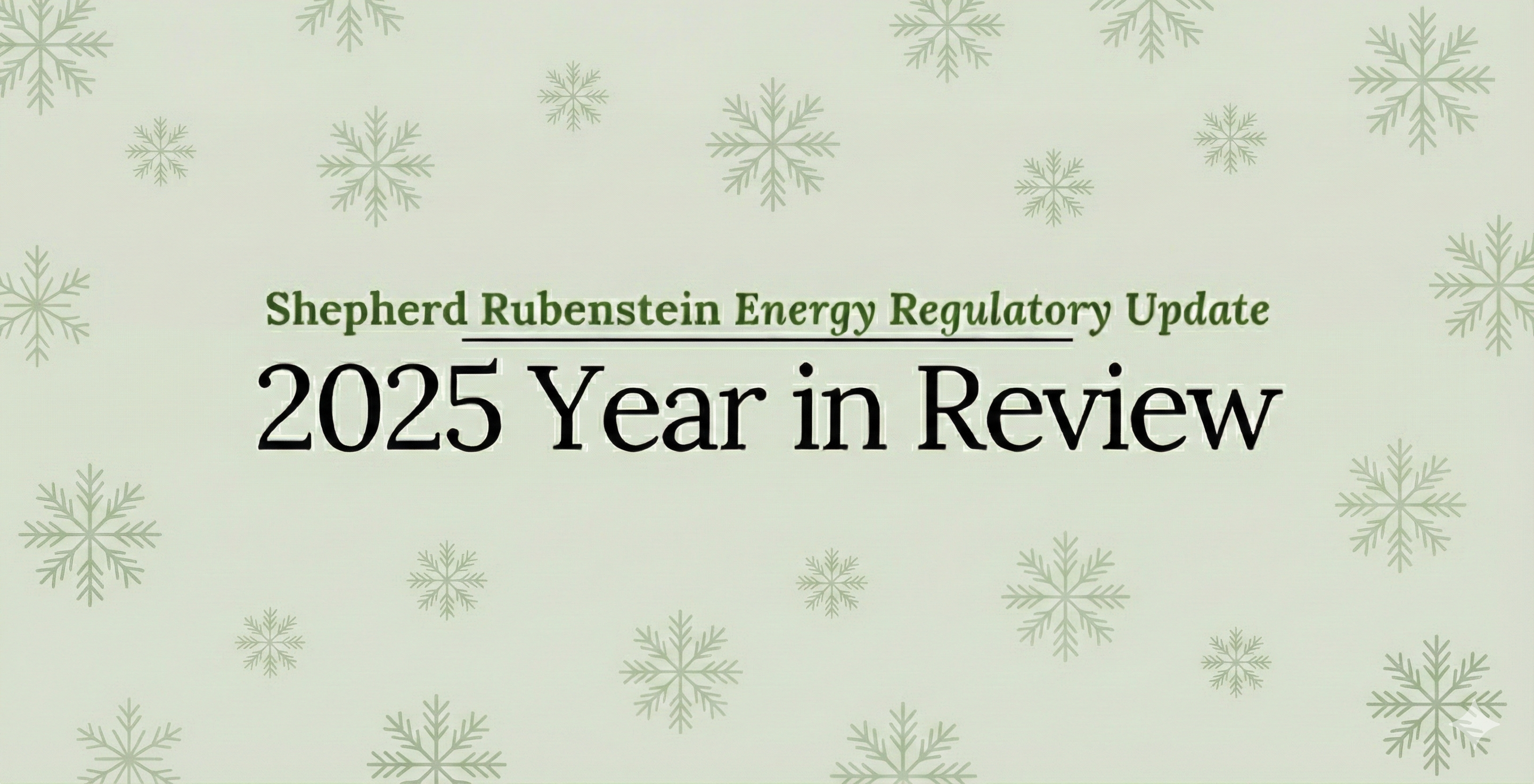Welcome to the latest edition of the Shepherd Rubenstein Energy Regulatory Update, a quarterly round-up of the important developments in the Ontario energy sector. Below are some of the key regulatory happenings between July and September.
Ontario Energy Board
The OEB issued a number of notable decisions, including:
- Approving the IESO’s request for incremental funding for 2024 and 2025 to support the Powering Ontario Growth Plan. The OEB found that section 25(1) of the Electricity Act permits the IESO to seek a change in its usage fee, notwithstanding specific provisions of a previously approved Settlement Proposal that had detailed the limited circumstances under which it could adjust its fees for those years.
- Approving Essex Powerlines’ request for the establishment of a new deferral account to record costs of energy and capacity payments made to participants of its PowerShare Distribution System Operator pilot project. In approving the account, the OEB capped the level of costs that could be recorded (at an amount lower than had been proposed) and required public reporting on the pilot’s progress.
A consultation was launched to review and evaluate the Incremental Capital Module (ICM) Policy.
To reflect changes to policies and other guidance documents since its release, the OEB released an update to its Innovation Handbook.
The OEB held a stakeholder session to seek feedback on the implementation of two possible alternative pricing plans for Non-RPP Class B Customers. As part of its Transmission Connection Review, the OEB announced the members of working groups and an issues list.
Final amendments to the Distribution System Code (DSC) and Transmission System Code (TSC) were issued requiring utilities to comply with the new Ontario Cyber Security Standard.
The OEB issued updated Filing Guidelines for Ontario Power Generation payment amount application. They also issued new filing requirements of applications for exemptions from the requirement for leave to construct natural gas (and other hydrocarbon) pipelines contemplated under sections 90(2) and 95(2) of the OEB Act, and the newly amended Ontario Regulation 328/03.
The Market Surveillance Panel (MSP) delivered its State of Market 2023 Report.
The OEB issued a letter outlining several ongoing and new commitments to its data transparency initiatives, including among other open data releases, providing access to RRR data for electricity transmitters.
As part of preparing its report to the Minister of Energy and Electrification, which was delivered in September, the OEB held a stakeholder meeting in August on its Consumer Advocate and Cost Award Process Review to share preliminary findings and recommendations from its expert consultant and to seek feedback.
Seven more Assurances of Voluntary Compliance (AVC) were accepted from electricity distributors (Renfrew Hydro, Lakefront Utilities, Lakeland Power, London Hydro, PUC Distribution, Ottawa River Power, and InnPower Corporation) related to billing errors that resulted in the over-charging of customers through the fixed monthly service charge. Two AVCs were also accepted from electricity wholesalers for operating without a license (Norbord and Northern Tel LP).
Independent Electricity System Operator
During the last quarter, the IESO undertook further consultations on the development of its planned Long-Term 2 RFP (LT2 RFP). In late August, the Minister of Energy and Electrification wrote to the IESO requesting a report by late September on options to accelerate the final targets, timelines, and design elements for the LT2 RFP, with the goal of accelerating and concluding the procurement by the end of February, 2026. The Minister also sought options for procurement of resources requiring longer development lead times. As part of the letter, the Minister outlined expectations regarding additional policies that should be reflected in the IESO’s LT2 design, including, among others, that procurement should be technology-agnostic, require municipal support and access to Crown Land, consideration of rating criteria for new projects in certain Northern Ontario communities, and incentivizing the participation of Indigenous communities
The Minister also noted his support for the IESO’s proposed Enhanced Power Purchase Agreement (E-PPA) revenue model for energy projects, and expressed an expectation, that for capacity projects the contracts will be similar to those used in the LT1 RFP.
The IESO launched a Request for Information (RFI) focused on long lead time resources, specifically long duration energy storage and hydroelectric generation.
As expected, the IESO began consultations on a second Medium Term RFP (MT2-RFP) with an expected proposal deadline of January 2025. The MT2-RFP will have both a capacity and energy stream focused on reacquiring existing resources, whose contracts are ending no later than April, 2029.
The Technical Panel unanimously recommended approval of the final alignment batch of market rule amendments to implement the Market Renewal Program (MRP), This came after the IESO made a number of substantive changes to the market rules (and manuals), including establishing a Market Power Mitigation Working Group. The Technical Panel also recommended approval of market rule amendments related to the Capacity Auction. Those latter amendments were subsequently approved by the IESO’s Board of Directors.
The IESO completed stakeholder engagement on a proposed Transmission Selection Framework in preparation for its required report to the Minister of Energy and Electrification in September. The IESO’s proposed design is that for certain eligible projects, the IESO will undertake an RFQ of qualified transmitters to bid into an RFP. To be selected, a proponent will be required to demonstrate Indigenous participation. The selected proponent would be awarded a partial contract to run until a short period after commercial operations. The partial contract would include the design and construction, as well as a fixed level of O&M costs. The contract amounts would be required to be included in a cost of service application with the OEB, and some or all of the post-commercial operations revenue would be fixed via contract and incorporated into the Uniform Transmission Rates (UTRs).
The IESO released the York Region Non-Wires Alternative Demonstration Project Evaluation Final Report. The IESO also released the latest 18-month Reliability Outlook.
Legislative and Regulatory
The Ministry of Energy and Electrification proposed to declare the planned transmission line from Wawa TS to Porcupine TS as a priority project under section 96.1 of the Ontario Energy Board Act and to designate Hydro One as the transmitter.
Government of Ontario also:
- Issued Ontario Regulation 273/24 under the Ontario Energy Board Act, specifying the revenue horizon for the setting of natural gas rates. This new authority was part of the amendments to the Ontario Energy Board Act included as part of Bill 165, Keeping Energy Costs Down Act, 2024.
- Proposed to amend Ontario Regulation 509/18 under the Electricity Act, to among other matters, expand rolling incorporation for 42 products already harmonized with NRCan requirements,
Federal Government
The Government of Canada released its new Canada Green Buildings Strategy. Natural Resources Canada launched a Request For Proposal under its Zero Emission Vehicle Infrastructure Program (ZEVIP) to support development of EV chargers, including fast chargers across the country.
The Impact Assessment Agency of Canada sought feedback on a discussion paper regarding a five-year review of the Physical Activities Regulations (commonly referred to as the Project List) made under the Impact Assessment Act.
The Canadian Energy Regulator (CER) launched a review of its rules of practice and procedure. As part of the review, it issued a discussion paper and is seeking written feedback.
Judicial Decisions
In August, the Ontario Superior Court released its decision in West Whitby Landowners Group Inc. v. Elexicon Energy, dismissing an application as an abuse of process. The application was brought by a group of developers who had a dispute with Elexicon Energy regarding the provisions of an Offer to Connect agreement. They had previously challenged the OEB staff opinion letters on the merits of the dispute (which were requested by the developers and Elexicon), and the escalation to a formal complaint, which the Divisional Court had found was not subject to judicial review. The group of developers now argued that, since the OEB had only provided its views, the underlying dispute had not been decided. In its decision, the Court found that the application was an abuse of process, as the matter had been dealt with by the OEB. Additionally, it found that the core of the issue underlying the initial dispute, the interpretation of the Distribution System Code, falls within the exclusive authority of the OEB
Shepherd Rubenstein News
Both Jay Shepherd and Mark Rubenstein were listed in the 2025 edition of ‘Best Lawyers’. Mark was ranked by Chambers Canada in its 2025 guide.
As always, if you have any questions, or think we can be of assistance to you or your organization, please do not hesitate to reach out to Mark Rubenstein at mark@shepherdrubenstein.com.
Click here for pdf version.


